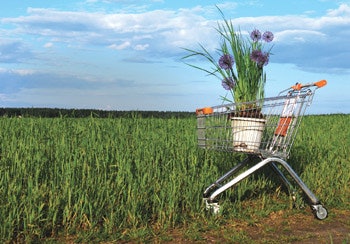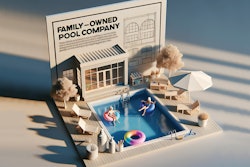
The term "greentailing" may conjure up images of solar-powered stores selling hempen handbags or composting bins, but according to industry experts, any retailer can get into it — even those that sell products that aren't commonly viewed as being green.
"One of my biggest clients in recent years has been Toyota, and we've been helping them identify how individual dealers can implement green strategies that make sense to them," says Rick Ferrera, an architect and retail practice area leader for San Francisco-based Gensler. "People do ask me, 'How in the world can you green a car dealership? They're one of the biggest environmental offenders on the planet!' Well, they're really not. The car manufacturers make their cars greener and greener and greener every year, and when you look at it, the emissions are a tiny fraction of what they were a generation ago."
Spa and pool businesses can make similar claims. Manufacturers of heaters, pumps, lighting and filtration equipment have made giant strides in energy efficiency; chemical manufacturers and bottlers have sought ways to limit landfill from used packaging; cover manufacturers put a lids on pools and spas to protect investments in energy, chemicals and water; and builders and engineers have improved hydraulic design to save energy and money. The products are all growing greener.
But how exactly do you green a pool and spa store? Do you need to add a rain barrel to the front of the store and photovoltaic panels and a windmill on top? Luckily, it's a lot simpler than that.
Green Light
Many of Ferrara's clients begin the greening process with their sights set unrealistically high, so the first step is to narrow the scope of the client's expectations and zero in on what really saves energy and money and doesn't break the bank.
"My advice for years has been to look at your business and say, 'Where are there opportunities to do things a little bit better? Where can we make incremental changes where the savings in expenses will help us pay for the changes?'" he says.
We posed that question to Rachel Zsembery, an architect in Boston who designs retail spaces for Bergmeyer Associates.
"The easiest thing that we find for retailers that are looking to communicate to their customers that they're doing something that's green, that will save the retailer money and won't cost them a lot is to look at their lighting," she says. "That is the No. 1 way any retailer we work with uses to go green — whether it's a mom-and-pop store or Staples.
"So that's looking at a more energy efficient compact fluorescent, or even LED."
Zsembery and Ferrara both cite LED's recent rise among retailers, adding that the added initial cost is more than made up for by lower cost of operation and longer lamp life.
"So that's certainly a conversation they can have with their customers, and it's a cost savings to them," Zsembery explains. "And, a lot of our retailers are looking at daylighting, if it's feasible, and that's something that is very green and very visible to the customers who walk into a store. They'll see the lights are out and that the retailer is harvesting daylight."
Daylighting has another big benefit, according to Zsembery, who says natural daylight is more conducive to browsing and products often show better than when they're lit artificially.
Ferrara agrees: "In retail, it's not just about providing ambient lighting for office workers, it's about marketing goods and creating a little sizzle and showcasing the more expensive products we'd like to move more of and really making a nice retail experience for the customer. So lighting is certainly a big thing."
Conditioning Clinic
The next thing Zsembery and Ferrara recommend improving is the HVAC system, which they admit isn't an option for everyone, but is it important to consider replacing it if you can.
Ferrara typically asks the engineer on the project to show him two HVAC options — the cheapest to buy and the cheapest to own — then he'll talk about the cost of each with the client, before letting him or her weigh the different factors and come to a decision. For people planning to stay in a building for just a short time, it may be difficult to get the return on investment for a greener, high-efficiency system.
"But if they're established and the neighborhood is good and they're going to be there for five or 10 years, they'll probably want to spend the money and enjoy the benefit year after year after year, beginning in about year four," he says.
These building improvements not only save money, they allow the retailer to tell customers a compelling story. Discreetly done, signage at the point of sale or near the register lets customer know you're taking responsibility for your impact on the environment. This is an effective way to connect with customer, especially younger ones, who increasingly look to do business with companies whose values mirror their own.
"Customers certainly want to know there's something being done about the environment, and that the company they're about to give a bunch of money at least cares," says Ferrara. "They don't expect it to be super deep, but they do expect a pool store to at least acknowledge that they have a role to play in the community and that they're doing something in a positive direction. It can be something as simple as recycling containers. And how cool would it be if as you're doing your transaction at the countertop, you could tell the customer the counter is made of recycled buckets, some of which may well have contained pool supplies?"
Visibility
While lighting and HVAC improvements are where the real earth- and money saving come in, it's things like recycled-chemical-bucket countertops that tend to get more attention from shoppers.
"I can design a sustainable building that you can't tell is sustainable, because most of the effort is going to go into technology," Ferrara says. "So we do have to then go back and make sure the materials inside the store are green. We work really hard to pick materials with a story to tell. Otherwise it's all about air-conditioning and glass specs and things that aren't very sexy.
"So with the material selection, we're looking for opportunities to be able to have conversations about sustainability with the customers in the store. It makes the owner feel good, and it makes the customer feel good. It's a win-win."
Among the easiest ways to specify sustainability into the store is to choose carpeting containing a percentage of recycled material and paint with a low percentage of volatile organic compounds.
"All the major manufacturers have a line out there that's low-VOC," says Zsembery. "And frankly, I think they're better products. They cover extremely well, and the odor and off-gassing are dramatically reduced.
"Using sustainable materials is very easy and can be fairly inexpensive given all the strides that have been made. You have carpeting and vinyl with recycled content, then more visible things like reclaimed wood that have the look and feel that customers associate with sustainability. In addition, you know you're purchasing a product that is diverting material from a landfill."
Easy Pickin's
One thing Ferrara stresses repeatedly is that greening a retail store isn't as difficult as it may seem at the outset. He likes to focus on the low-hanging fruit of lighting, HVAC and, for bigger budgets, building controls to shut circuits down automatically and make outlets go dark when the store is closed. Otherwise, he says, it's a lot of common-sense solutions. Reduce. Reuse. Recycle.
"It's things you do at your house," he explains. "If you don't have the building controls, get a $40 or $50 thermostat that's smart, then use it and check it every once in a while to make sure the time and days of the week are still right. Or add a vestibule to keep heat in during the winter and cool air in during the summer. Are your salespeople being blinded by the setting sun every afternoon at 4:30? Let's look at some window treatments we can lower during those bad hours when the sun is pouring into the store.
"I realize, too, that if I'm a pool and spa dealer, I'm picking a spot because it's got visibility and traffic, not because of where the sun sets. So we've got to look at the realities of each situation."
Story Lines
Going green, then, is really about creating a narrative for your customers. It's about sparking conversations and demonstrating to them that you share their values. Some of it's apparent to the plain eye, some needs to be explained.
"One thing we do with any client when we start out is to ask them what is important to them," says Zsembery. "It's important to understand what you're trying to get out of it. Do you want the store to have that sustainability feel, so that the efforts are visible? Or do you care less about it being visible and more about saving money and doing the right thing?
"Everybody has different answers to those questions, and everybody has a different amount to invest into it. So you really need to evaluate where those two things intersect at the outset."
Ferrara sums up the situation like this: "There aren't too many car dealers or hot tub dealers that are tree huggers, but they sure like to hold onto the green cash. It's a great marketing opportunity, and a sincere one."
Comments or thoughts on this article? Please e-mail [email protected].







































